Information produced by ADM Investor Services, Inc. and distributed by Stewart-Peterson Inc.
Wheat prices overnight are down 3 in SRW, down 1/4 in HRW, down 1 1/4 in HRS; Corn is down 1/4; Soybeans up 3; Soymeal up $0.24; Soyoil down 0.15.
For the week so far wheat prices are down 12 in SRW, down 9 1/2 in HRW, down 7 1/2 in HRS; Corn is down 15 3/4; Soybeans down 7; Soymeal down $0.54; Soyoil up 0.54.
For the month to date wheat prices are up 4 1/4 in SRW, up 13 in HRW, up 8 1/4 in HRS; Corn is up 3 1/4; Soybeans up 33 1/4; Soymeal up $7.60; Soyoil up 1.71.
Year-To-Date nearby futures are down 11.5% in SRW, down 5.7% in HRW, down 7.2% in HRS; Corn is down 5.6%; Soybeans up 0.2%; Soymeal up 2.3%; Soyoil down 3.8%.
Like what you’re reading?
Sign up for our other free daily TFM Market Updates and stay in the know!
Chinese Ag futures (MAY 23) Soybeans down 40 yuan; Soymeal up 22; Soyoil up 86; Palm oil up 86; Corn down 4 — Malaysian palm oil prices overnight were up 58 ringgit (+1.35%) at 4352.
There were changes in registrations (-24 Oats, -180 Corn). Registration total: 2,587 SRW Wheat contracts; 43 Oats; 172 Corn; 412 Soybeans; 817 Soyoil; 0 Soymeal; 352 HRW Wheat.
Preliminary changes in futures Open Interest as of March 2 were: SRW Wheat up 1,165 contracts, HRW Wheat up 58, Corn up 11,430, Soybeans up 1,186, Soymeal up 5,342, Soyoil down 4,191.
Brazil Grains & Oilseeds Forecast: Scattered showers continue for much of Brazil’s growing regions for the next week outside of Minas Gerais, where showers will be more limited. Despite recent rains, many areas have made significant progress with regards to soybean harvest and corn planting. However, some areas are behind, somewhat significantly, and will expose more of the corn crop to the dry season, which will start up in April. Corn already in the ground will benefit from good soil moisture.
Argentina Grains & Oilseeds Forecast: Dry conditions continue to be a concern for immature corn and soybeans in Argentina moving forward. Any showers will be limited for at least the front half of March, though isolated showers may move through at times. Another burst of heat this week continues into next week. The heat and dryness is keeping stresses high for both crops in various stages of growth.
Northern Plains Forecast: Temperatures will remain near to below normal across the Northern Plains and Canadian Prairies through the weekend. A system will move through Sunday and Monday with scattered snow but will pull much colder air into the region that should last for a while, stressing livestock.
Central/Southern Plains Forecast: A large storm system will move through the Central and Southern Plains Thursday. This system will produce widespread precipitation, including some snow, strong winds, and severe weather. While any precipitation will be welcome, amounts are not expected to be very heavy across the southwestern drought areas. A front will go through the region next week, bringing in another round of very cold air, but also some more chances for precipitation later next week.
Midwest Forecast: A strong system will move through the Midwest late Thursday through Friday with widespread precipitation including a band of moderate to heavy snow from Missouri to Michigan. Another storm will move through Sunday to Tuesday. This system will be weak with only scattered showers, but will push a strong cold front through the region with much colder air settling in for the remainder of the week. A system will likely move through late next week and weekend with widespread precipitation.
The player sheet had funds net buyers of 3,000contracts of SRW Wheat; sellers of 2,000 corn, buyer of 6,000 soybeans, buyers of 2,000 Soymeal, and; net buyers of 2,000 lots of Soyoil.
TENDERS
- WHEAT PURCHASE: Iranian state agency the Government Trading Corporation (GTC) is believed to have purchased Russian-origin milling wheat in a tender which closed on Wednesday
- CORN TENDER PASSED: South Korea’s largest animal feed maker Nonghyup Feed Inc. (NOFI) is believed to have rejected all offers and made no purchase in an international tender on Thursday to buy up to 138,000 tonnes of animal feed corn
- FEED BARLEY PURCHASE: Turkey’s state grain board TMO provisionally bought about 465,000 tonnes of animal feed barley in an international tender on Thursday
- WHEAT PURCHASE: Japan’s Ministry of Agriculture, Forestry and Fisheries (MAFF) bought a total of 70,065 tonnes of food-quality wheat from the United States and Canada in a regular tender that closed on Thursday.
- WHEAT TENDER: Jordan’s state grain buyer issued an international tender to buy up to 120,000 tonnes of milling wheat which can be sourced from optional origins
- FEED BARLEY TENDER: Jordan’s state grains buyer issued an international tender to purchase up to 120,000 tonnes of animal feed barley.
- FEED BARLEY TENDER: Tunisia’s state grains agency issued an international tender to purchase an estimated 25,000 tonnes of animal feed barley.
- CORN TENDER: Taiwan’s MFIG purchasing group has issued an international tender to buy up to 65,000 tonnes of animal feed corn which can be sourced from the United States, Brazil, Argentina or South Africa
PENDING TENDERS
- FEED WHEAT AND BARLEY TENDER: Japan’s Ministry of Agriculture, Forestry and Fisheries (MAFF) said it will seek 70,000 tonnes of feed wheat and 40,000 tonnes of feed barley to be loaded by June 30 and arrive in Japan by Aug. 31, via a simultaneous buy and sell (SBS) auction that will be held on March 8.
US BASIS/CASH
- Basis bids for soybeans and corn transported by barge to the U.S. Gulf Coast held steady on Thursday, while corn export premiums firmed a bit, supported by exporter demand after a plunge in corn futures to six-month lows this week stirred expectations of fresh business, traders said.
- U.S. soybean export sales for the week totaled 494,700 tonnes (old and new crop years combined), compared with expectations for 300,000 to 1.05 million tonnes, and wheat sales of 300,900 tonnes were in line with expectations.
- Barge freight costs were mostly flat on Thursday but firmed on the Illinois River. Forecasts called for rising water levels on the Illinois and mid-Mississippi rivers through early next week that could slow barge movement, traders said. A few locations on the Illinois River were at minor flood levels on Thursday afternoon, National Weather Service data showed.
- CIF corn barges loaded in March were bid at 78 cents over March, unchanged from Wednesday.
- FOB basis offers for March corn shipments were around 88 cents over futures, up 2 cents from Wednesday.
- CIF soybean barges loaded in March were bid at 89 cents over March futures, unchanged from Wednesday.
- FOB offers for March soybean shipments held steady at around 105 cents over futures.
- Spot basis bids for U.S. soybeans delivered to Midwestern elevators, river terminals and processors were steady to higher on Thursday, dealers said.
- Basis bids are firm as processors seek to secure soybeans for crushing at a time when margins are strong, analysts said.
- Demand from end users perked up after futures prices Sv1 slid to a multi-week low on Tuesday, traders said.
- Grain dealers continue to roll basis bids to May futures contracts from March futures.
- Farmer sales remain limited, dealers said.
- Spot basis bids for soybeans remained mostly steady at U.S. Midwest elevators and processors on Thursday, grain dealers said.
- The spot soy basis jumped by 5 cents a bushel at a processing plant in Lafayette, Indiana.
- Soybean futures strengthened, extending their rebound from the one-month low hit earlier this week on a round of technical buying, traders said.
- Dealers continued to roll grain and soy basis bids to May futures contracts from March futures.
- Spot basis offers for soymeal were steady in some truck market locations on Thursday amid lackluster demand, dealers said.
- A dealer said there was a weak tone to the market, with production seen as good and logistics moving along. Export demand was unimpressive, he said.
- Spot basis bids for hard red winter wheat were flat in the southern U.S. Plains on Thursday as futures advanced, grain dealers said.
- Protein premiums for hard red winter wheat delivered by rail to or through Kansas City were steady, according to the latest CME Group data.
- Colder weather is expected in the central Plains next week, though there is minimal threat for damage to wheat crops, Commodity Weather Groups said. Dryness persists for the southwestern quarter of the Plains wheat belt, the firm said.
- U.S. cash millfeed values held steady on Thursday, but prices remained under pressure in the Midwest and Plains regions due to plentiful flour mill output and sluggish demand from animal feed makers, brokers said.
- In the eastern half of the country, millfeed prices appeared to have stabilized after softening in recent weeks.
- Spot basis offers for soymeal were steady in some truck market locations on Thursday amid lackluster demand, dealers said.
- A dealer said there was a weak tone to the market, with production seen as good and logistics moving along. Export demand was unimpressive, he said.
US Agriculture Export Sales for Week Ending Feb. 23

US Export Sales of Soybeans, Corn and Wheat by Country
The following table shows US export sales of soybeans, corn and wheat by biggest net buyers for week ending Feb. 23, according to data on the USDA’s website.
- China bought 350k tons of the 495k tons of soybeans sold in the week
- Mexico was the top buyer of corn and Japan led in wheat
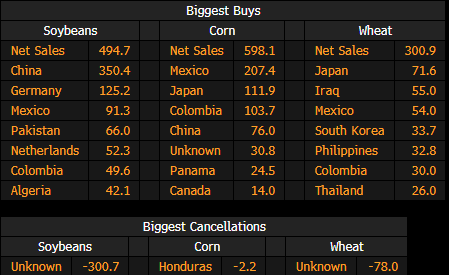
US Export Sales of Pork and Beef by Country
The following table shows US export sales of pork and beef product by biggest net buyers for week ending Feb. 23, according to data on the USDA’s website.
- Mexico bought 13.4k tons of the 31k tons of pork sold in the week
- Japan led in beef purchases

Argentina Crops To See Relief Next Season After Three Ninas
Weather in the 2023-24 planting season should improve for crops as a neutral or El Nino climate pattern supplants a La Nina in 2Q, according to a Buenos Aires Grain Exchange report.
- NOTE: Argentina has suffered three straight La Ninas, with the 2022-23 wheat, soy and corn crops hit particularly hard by drought
- NOTE: La Nina normally brings dryness to Argentina; El Nino brings rain
- Still, rain maps in the report show dryness in much of the key “zona nucleo” region persisting through June, meaning fields won’t immediately recover moisture levels
- “The impact of an El Nino phenomenon only begins to be felt at the start of 4Q, making it unlikely we’ll see signs of it in 2Q and 3Q”
- NOTE: 4Q is when wheat plants are harvested after growing in 3Q. It’s also when most soy, corn are planted
Argentine Soybean, Corn Estimates March 2: Exchange
The Buenos Aires Grain Exchange releases weekly report on website.
- 2022-23 corn production held at 41m tons
- Soybean production held at 33.5m tons

Another Dry Week Ahead Seen for Key Argentina Crop Area: Bourse
The heart of Argentina’s soybean and corn belt will receive very little rain during March 2-8, according to weather maps in a Buenos Aires Grain Exchange weekly forecast.
Argentina Soy Forecast to Be Cut Again, Grain Exchange Says
Heat waves and dryness continue to hurt soy fields at a time when 62% of plants are in yield-defining growth stages, the Buenos Aires Grain Exchange said in its weekly report.
- Mounting losses in key central areas will lead bourse analysts to cut the current production estimate of 33.5m metric tons
- NOTE: 67% of the crop is in a poor or very poor condition, up from 60% last week and 56% two weeks ago, according to a separate bourse report
- The exchange said it may cut its 41m-ton corn estimate with late-planted fields also suffering from heat and drought
- NOTE: Farmers are pinning hopes on late corn after the early crop was largely ruined by the dryness
UN Sees Global Wheat Output Falling for First Time in Five Years
- Wheat production expected to fall slightly in 2023-24 season
- Drop is partly due to lower production in Russia and Ukraine
Global wheat output is expected to drop slightly next season from a record high as the war in Ukraine and dry weather in Russia takes a toll on crops, the United Nations said.
Production should fall roughly 1% to 784 million tons in the 2023-24 season, the UN’s Food and Agriculture Organization said Friday. That would be the first decline in five years and highlights the risk that global grain supplies still face from Moscow’s invasion of Ukraine.
Crop prices were volatile last year as the invasion disrupted trade, but wheat and corn have now returned to pre-war levels.
The FAO estimates that Ukraine’s winter-wheat area has fallen 40% in the wake of the war due to financial constraints, damage to infrastructure and problems accessing fields. In Russia, dry weather in some regions and lower prices have curbed sowing and will result in the harvest falling from a record, it said.
India Says Wheat Crop Is Normal in All Major Growing Areas
The wheat crop in India’s Punjab, Haryana, Uttar Pradesh, Rajasthan and Madhya Pradesh states, which account for more than 85% of the planted area, is in normal condition, according to a statement by the farm ministry.
- Indian farmers have planted heat tolerant varieties in more than than 50% area mainly in the northwestern region
- About 75% area in northern states of Punjab and Haryana was sown early and that will protect the crop from any heat wave conditions in March
- The farm ministry is monitoring the status of the wheat crop on a weekly basis
India Sticks to Wheat Export Ban as Citi Sees Chance of Imports
- Higher probability of heat waves is expected through May
- Louis Dreyfus sees India possibly becoming wheat importer
India is keeping to its ban on wheat exports on fears that scorching temperatures will damage crops, with Citigroup Inc. predicting that the government could even change the rules to make imports easier.
The weather office has warned of an increased probability of heat waves from March to May. That’s bad news for the wheat crop, currently at a critical growth stage that makes it particularly sensitive to heat. To safeguard local supplies, the government has decided to keep the curbs on wheat exports.
“Since the export ban is going to continue, we expect that there will be more wheat available for the public procurement,” Food Secretary Sanjeev Chopra said late Thursday. There’s no report of damage to the crop yet and he’s optimistic that output will rise to hit the official estimate of 112 million tons.
India is taking steps to avoid a repeat of last year, when record-breaking heat parched fields and slashed output. It forced the government to halt exports in May, a shock move that exacerbated fears of global food shortages and inflation amid the war in Ukraine. This year officials set up a panel to monitor the crop and are advising farmers on how to take care of their plants.
‘Extra Mile’
“The government seems to be ready to go the extra mile to proactively avert a repeat of last year’s dismal situation,” said Citigroup economists Samiran Chakraborty and Baqar M Zaidi. They expect increased intervention, including stockholding limits, a continued ban on exports and the removal of a 40% import duty on wheat, according to the report.
The likelihood of India becoming a wheat importer was flagged this week by Louis Dreyfus India Deputy Chief Executive Garima Jain. She said production may not be that great due to adverse weather, while stockpiles are low.
Currently the wheat crop is in normal condition across major growing regions, with farmers having sown heat-tolerant varieties, the farm ministry said. The government has announced the sale of 5 million tons from reserves to cool prices. Chopra said wheat costs will fall further with the new crop’s arrival.
More details from the food secretary:
- There is no proposal to scrap the duty on white rice exports for now. When the government feels comfortable with domestic supplies, it will consider lifting the export ban on broken rice.
- India doesn’t plan to allow more sugar exports this season. Output is likely to be lower than last year due to bad weather. The government will assess stockpiles first before deciding on exports.
India’s 2022/23 vegoil imports seen at 15 mln T – brokerage
India’s edible oil imports are forecast to climb to 15 million tonnes in the year to October 2023, up from 14.15 million tonnes shipped a year ago, a leading broker said on Friday.
“India’s population is growing, we have more than 1.4 billion people,” Sandeep Bajoria, chief executive of Sunvin Group, a vegetable oil brokerage and consultancy firm, said at a grains conference in Singapore.
“With per capita consumption of 17 kg and strong economic growth, we expect India’s edible oil imports will rise.”
Imports of palm oil by India, the world’s biggest buyer, are estimated to rise to 8.75 million tonnes during the year as compared with 8.26 million tonnes a year ago, he said.
Bajoria forecast soybean oil purchases at 3.75 million tonnes in 2022/23, down from around 4.0 million tonnes last year.
“Palm oil’s discount to soyoil is pretty wide and we expect palm oil get a bigger share of the market.”
For sunflower oil, India’s imports are expected to rise to 2.5 million tonnes in 2022/23, up from 1.88 million tonnes a year ago.
Ukraine Starts Spring Sowing Campaign: Agriculture Ministry
Ukraine’s farmers have started spring sowing campaign in the country’s south, Agriculture Ministry says on its website.
Farmers in Odesa region have already planted 3,500 ha with spring grains, including 1,500 ha with spring barley
Ukraine doesn’t plan to curb 2023/24 wheat exports -govt official
Ukraine sees no need to limit wheat exports for the upcoming 2023/24 July-June season, as the winter harvest looks to be larger than expected, albeit smaller than in peacetime, a top agriculture ministry official said on Thursday.
Ukraine was the world’s fifth-largest wheat exporter before the war with Russia, and its shipments were especially important to poor countries in Africa and the Middle East.
Based on results collected by the Ministry of Agrarian Policy and Food as well as satellite images, farmers planted more wheat in southern areas than the ministry had forecast in autumn, first deputy farm minister Taras Vysotskiy told Reuters.
“The (supply) balance is positive and so far there are no reasons for it,” he said of government-imposed limits to wheat exports that would preserve more wheat for domestic consumption.
Some Ukrainian agriculture groups have suggested that the government may introduce limits on wheat exports, fearing a shortage of milling wheat at home after a smaller, poor-quality harvest.
The ministry now estimates that farmers planted 4.1 million hectares of winter wheat nationally, up from its estimate in October of 3.7 to 3.8 million hectares, Vysotskiy said, adding that the ministry planned to formally release the new forecast on Monday.
The planted area is still sharply lower than before the war, when farmers seeded 6.2 million hectares.
The size of Ukraine’s wheat crop depends largely on the rainfall it will receive in spring, before farmers harvest it, Vysotskiy said.
The harvest may range from 16 million to 18 million tonnes, he estimated. Last year, Ukraine produced 20.2 million tonnes of wheat.
Ukrainian wheat exports have declined to 11.3 million tonnes so far this season from 18.1 million sold abroad in the same period in 2021/22, ministry data shows.
External factors may still limit how much wheat Ukraine can sell outside its borders.
The Black Sea grain deal with Russia, the United Nations and Turkey that allows some ships to move Ukrainian grain during the war is due to expire later this month. Some areas in the east and south are also heavily mined, and difficult to farm during the war.
Malaysia Palm Oil Stockpiles to Drop as Output Hits One Year-Low
- February stockpiles seen 1.8% lower from a month ago: survey
- Production will likely recover in second quarter, broker says
Palm oil stockpiles in Malaysia likely declined in February on expectations that poor weather and labor constraints pushed production in the second-biggest grower to a one-year low.
Stockpiles eased 1.8% from a month earlier to 2.23 million tons, according to the median of 10 estimates in a Bloomberg survey of analysts, traders and plantation executives. That compares with a 3.3% monthly increase in January. Holdings are still near the highest since 2019.
Crude palm oil production tumbled 7.2% to 1.28 million tons, the weakest since February 2022, according to the survey. Exports were seen little changed at 1.14 million tons.
The survey signals that Malaysia might not have gained much from Indonesia’s export curbs. The Indonesian government in February froze some export quotas and boosted domestic use of palm oil in biofuel. While that’s expected to benefit Malaysia, weak overseas demand remains a drag.
Expectations of lower stockpiles are a reflection of poor weather conditions and a persistent worker shortage, which hurt production, according to Paramalingam Supramaniam, a director at Selangor-based broker Pelindung Bestari Bhd.
“Exports, meanwhile, were lower due to the US dollar crunch in most destination markets, especially in Pakistan, Bangladesh and African countries,” he added.
Benchmark palm futures have jumped to the highest since November as the market assessed exports from Indonesia as well as the impact of floods on supply. Both Malaysia and Indonesia experienced heavy rains in recent weeks, which may hamper logistics and transport.
“Prices will remain defensive until production recovers in the second quarter,” Paramalingam said.
More details from the survey:
- Stockpile estimates ranged from 2.18 million to 2.30 million tons; production seen between 1.21 million and 1.34 million tons
- Export forecasts were from 1.10 million to 1.17 million tons
- Imports are expected to slump to 90,000 tons, compared with 144,937 tons a month earlier
- Local consumption estimates ranged from 250,000 tons to 320,000 tons
Ample Wheat Supplies May Get Another Boost From Canadian Farmers
- Canada farmers may sow more wheat instead of oats, pulses
- Wheat prices already falling amid bumper Russian harvest
One of the world’s top wheat exporters is poised to add to an already abundant breadbasket.
Acres of non-durum wheat in Canada could rise as much as 7.3% in 2023 as growers shift acres away from oats and pulses, said Neil Townsend, chief market analyst at FarmLink in Winnipeg, Manitoba. Farmers will probably plant 20.8 million acres of wheat, up from 19.4 million acres a year ago, according to FarmLink estimates.
The potential acreage boost comes as prices are being pressured from a bumper Russian harvest. Futures are down about 48% from highs set last year when Russia’s invasion of Ukraine spurred fears over shortages of grain from the Black Sea region, where much of the world’s food is produced.
Last year, Canadian farmers harvested the third largest wheat crop ever. Though prices are down now, their returns are still higher than those of oats, and sales for Canadian spring wheat have been strong, Townsend said.
“The demand has been really steady and they’re making good money on it and not having hassles with it,” he said.
Mexico Reports H5N1 Bird Flu Cases in Three Aguascalientes Farms
Mexico’s Service of Health, Safety and Agri-food Quality agency, known as Senasica, reported the presence of the H5N1 strain of avian influenza, known as bird flu, in three chicken farms in the municipalities of Asientos and Rincon de Romos, in the state of Aguascalientes, in the center of the country.
- The animal health department of the Agriculture Ministry ordered quarantine at the three farms, which housed 826,800 chickens, the ministry said in a statement
- The government began an epidemiological investigation in the area, taking samples from family and commercial farms
Iowa Governor Seeks Biden Meeting in Push to Avoid Ethanol ‘Gap’
Iowa Governor Kim Reynolds is requesting a meeting with President Joe Biden to make the case that the US should expedite a plan to boost ethanol gasoline sales.
- NOTE: The Republican governor’s comments come a day after the EPA proposed a policy shift sought by Reynolds and other Midwest governors that would encourage filling stations to sell higher-ethanol gasoline and offer the fuel year round
- NOTE: The change wouldn’t take effect until April 2024, but Reynolds and the industry want the policy shift to begin a few months from now
- The White House hasn’t responded yet, Reynolds tells reporters at the National Ethanol Conference in Florida on Thursday
- “There’s no reason to have this gap,” Reynolds says
Brazil Approves HB4 Wheat Planting
Brazil National Technical Biosafety Commission, known as CTNBio, approved the cultivation of Argentine transgenic wheat in a meeting on March 1.
US Miss. River Grain Shipments Fall, Barge Rates Decline: USDA
Barge shipments down the Mississippi river declined to 412k tons in the week ending Feb. 25 from 715k tons the previous week, according to the USDA’s weekly grain transportation report.
- Barge shipments of corn fell 51% from the previous week
- Soybean shipments down 39% w/w
- St. Louis barge rates were $14.24 per short ton, a decline of $0.71 from the previous week

SOUTH AMERICA

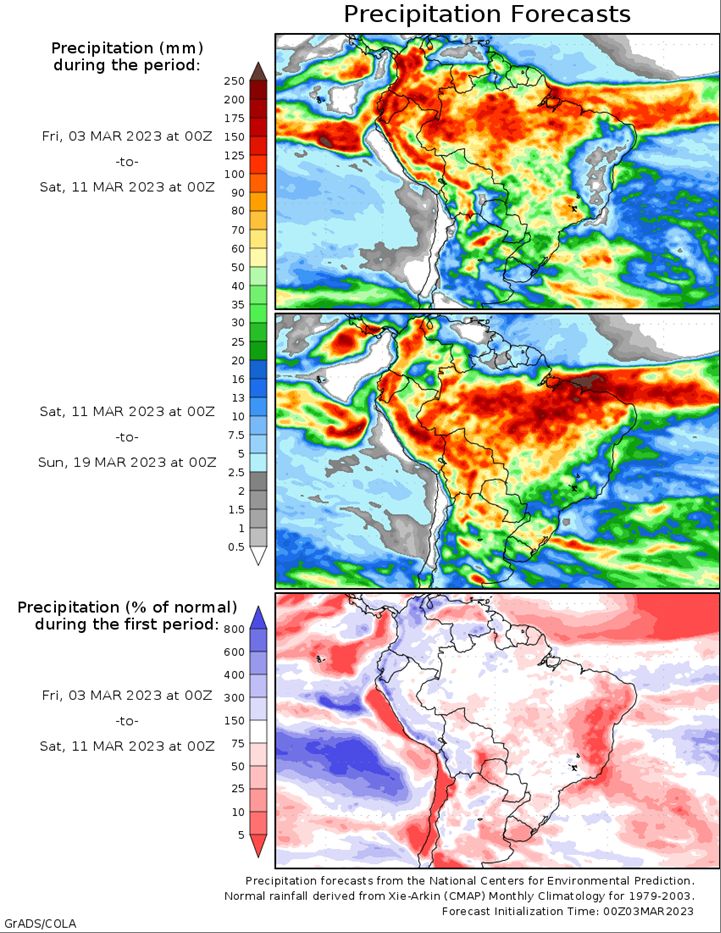

UNITED STATES
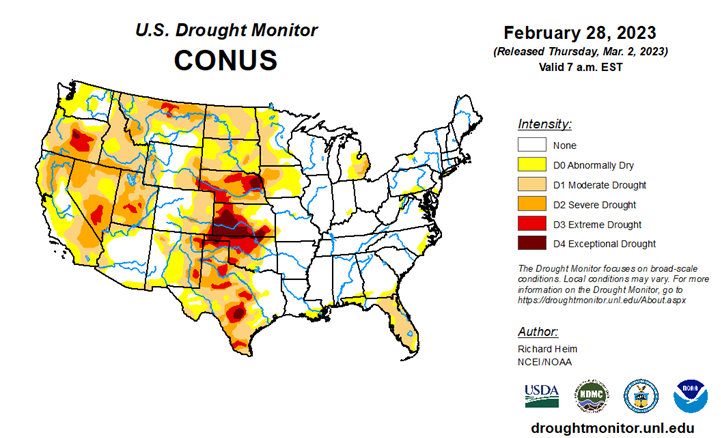
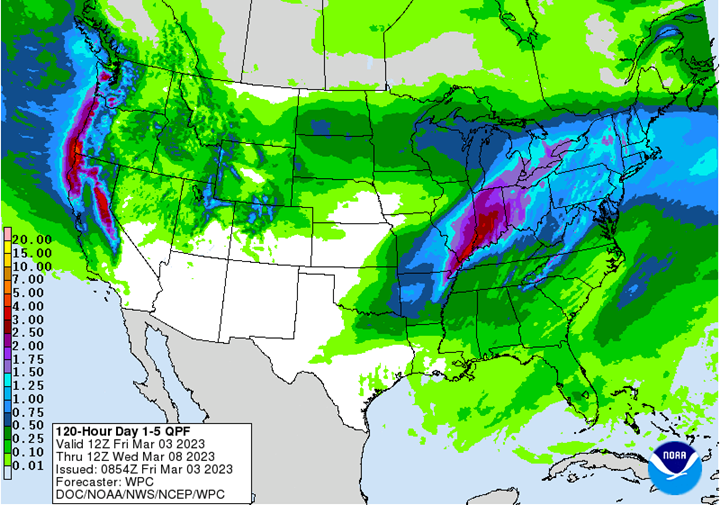

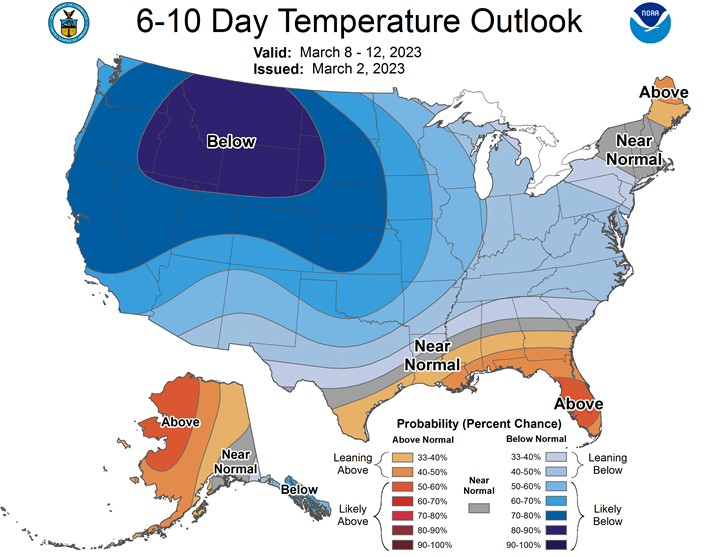


This commentary is provided by ADM Investor Services, a futures brokerage firm and wholly owned subsidiary of ADM Company. ADMIS has provided expert market analysis and price risk management strategies to commercial, institutional and individual traders for more than 50 years. Please visit us at www.admis.com or contact us at sales@admis.com to learn more.
Futures and options trading involve significant risk of loss and may not be suitable for everyone. Therefore, carefully consider whether such trading is suitable for you in light of your financial condition. The information and comments contained herein is provided by ADMIS and in no way should be construed to be information provided by Archer Daniels Midland Company. The author of this report did not have a financial interest in any of the contracts discussed in this report at the time the report was prepared. The information provided is designed to assist in your analysis and evaluation of the futures and options markets. However, any decisions you may make to buy, sell or hold a futures or options position on such research are entirely your own and not in any way deemed to be endorsed by or attributed to ADMIS.
| CONFIDENTIALITY NOTICE
This message may contain confidential or privileged information, or information that is otherwise exempt from disclosure. If you are not the intended recipient, you should promptly delete it and should not disclose, copy or distribute it to others. |

